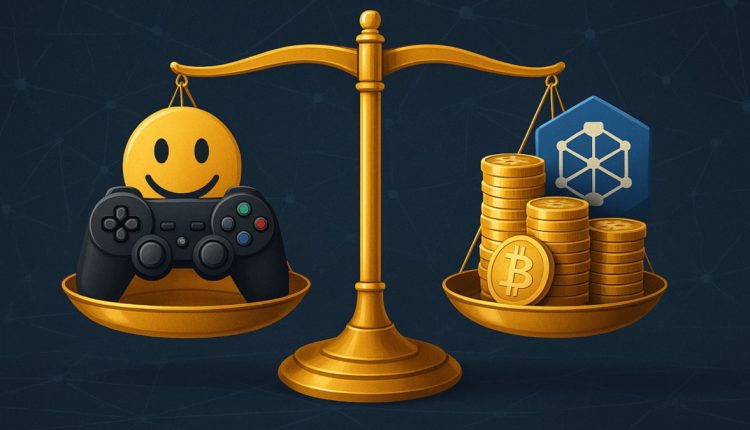Mavens: How can blockchain games balance fun and finance?

Welcome to the November edition of BlockchainGamer.biz’s regular Mavens group. This month we asked:
Why has it proven so difficult to balance the entertainment elements
with the financial aspects of blockchain games?
Hilmar Veigur Pétursson, CEO, CCP Games

The challenge of managing intrinsic and extrinsic motivation in games isn’t a new problem, but in blockchain games the extrinsic motivation factor can become quite dominant. As a consequence, many of the games I have seen in the space tend to be very focused on the extrinsic, often called financial aspects, which tends to leave them with underdeveloped and reductive intrinsic motivations to interact with the game or world.
By focusing more on the creation of:
- i) world
- ii) the emergent economy that arises from players needing to coordinate their efforts for world domination,
the whole stack needs to be built carefully and masterfully from the ground up. Only once all that has been achieved, financialization might make sense as the top layer. But just cutting to the end is skipping a lot of hard, required steps leaves an economy on a wobbly foundation.
So far in web3, I have not seen many take the time and care to do that, which is understandable as it requires a lot of expertise, money, and careful collaboration with a community of players over years.
Because games are about so much more than just entertainment, “to play” is a deeply human concept driven by learning and mastery of tools and challenges. Frameworks like mastery, autonomy and purpose are a lot better at capturing what good games are, along with flow state and other concepts focusing on the intrinsic rewards of participation. Focusing on satisfying deep human motivations rather than focusing on monetary rewards is the key to long-term success.
Robby Yung, CEO, Animoca Brands

I think the main challenge for game/economy balance in web3 games is that it’s really, really hard. Building a game economy in a web2 (hyperinflationary and closed) ecosystem is difficult enough, but when you add in fixed supply tokens that can trade outside the game, assets that can move in and out of the game, these add multiples of complexity. It’s one of the reasons that, early on in our web3 journey, we began recruiting a team of experts to build domain expertise in tokenomics, because it’s something that every web3 game dev can benefit from.
That said, to do it well, ideally-suited candidates would have backgrounds in highly complex multivariable systems, like physics, aeronautical engineering, and the like. This is often not something a game developer sees the need of recruiting, especially when it’s hard to see how much different open economy design will be from traditional closed economies.
The second part of the answer to this lies in thinking about what your player types are and how you build cohorts around their various motivations. Web3 games tend to attract an even more diverse player base, so rather than players motivated by entertainment time value, or achievement bragging rights, they can also now be motivated by collecting rare items they can own, farming fungible tokens for value, or a combination of these. It means that the game starts to resemble running a real economy, like a city or a country, more than it does a simple simulation. Keeping all of these balls in the air becomes quite a juggling act, but one that is highly rewarding if you can get it right.
Sunyoung Hwang, CEO, NEXPACE

Balancing entertainment and financial elements in blockchain games is challenging, not because developers cannot design it, but because of who is actually playing these games.
Web2 and web3 gaming remain quite separate. For traditional gamers, the threshold to try a web3 title is still high: security concerns, the perception that “crypto is complicated,” uncertainty around regulations in each country, and the extra steps of managing wallets, keys, and gas fees. Many players disengage before they ever reach the core fun of the game.
As a result, today’s web3 audience naturally skews toward users who are more open to perceived financial hurdles. Their first question tends to be “What’s the upside?” rather than “Is this game enjoyable?”. In this environment, even a carefully designed system that balances entertainment and rewards in theory may not behave as intended in practice. There simply aren’t enough “fun-first” players to balance out financially oriented behavior.
Regarding the broader gaming audience, two things must progress in tandem: clearer regulatory frameworks that make participation feel straightforward and safe, and UX innovations that let people simply start playing without requiring deep web3 expertise. When that happens, the player base will diversify, and a genuine balance between gameplay, enjoyment and financial elements will become realistically achievable for gaming projects.
Gabby Dizon, co-founder, Yield Guild Games

If you don’t have a very specific type of player in mind when you’re building a game, you’re going to have a hard time finding product-market fit. Provided that you’re making a game for a player base whose motivations match your game’s design, then you’re going to have maximum alignment between the entertainment and financial sides of your game.
Case in point, a lot of people in the industry get tripped up when they look at LOL Land and say it’s not fun like how Fortnite is fun. Of course it isn’t. We’re not trying to go after the people who play shooters. We want crypto natives playing our games and spending in our ecosystem. We’re after the players who have fond memories yield farming, trying different ICOs, and sitting in Discord minting NFTs with their friends.
We’ve found this approach to be very successful. Instead of going for hundreds of thousands of daily active users, we’d rather have 1,000 superfans playing our games; players who are more likely to have high crypto wallet balances. It’s actually kind of crazy how much this inverts the typical model for player acquisition you’d see in gaming. But we’ve found that it works, and it works very, very well.
Christina Macedo, CEO, PLAY Network

What’s interesting about this question is that whether you’re in web2 or web3, the challenge is fundamentally the same. Traditional gaming has long wrestled with the need to create positive revenue for the game while ensuring it feels fun, immersive, and not extractive. The difference with web3 or onchain games is that, for a long time, teams emphasized the financial layer above all else – launching game tokens or designing tokenomics as the central game mechanic. That approach initially drove attention and capital, but it also started to define what a “web3 game” was. It worked until it didn’t.
Now, the trend has flipped. We’re seeing more studios building onchain focus on launching their games first, generating in-game revenue, building engaged player bases, and only then considering how or whether to introduce crypto layers or their own tokens. This shift reflects a more mature understanding of what it means to design sustainable game economies.
Studios building onchain today are forced to think beyond token revenue , exploring models like in-game assets and asset merges, secondary marketplaces, ad monetization, power-ups, AI-driven features that are pay-as-you-go. All of this must be done while balancing multiple revenue funnels across different player segments, ensuring gameplay stays fun and rewarding rather than extractive.
But with those opportunities come new costs. Building onchain isn’t free, transaction fees can become a major burden at scale. If we truly want millions of players to migrate to onchain games, that could mean thousands more in daily costs for a studio. The economics have to make sense, and ultimately, building onchain needs to cost less overall for it to be viable at mass scale.
At PLAY, we see this clearly, it’s a balancing act between diverse revenue streams, smart onchain integrations, and emerging AI features. 2026 will be the year where this balancing act defines the space and the start of onchain games as a business.
Jack O’Holleran, CEO, SKALE Labs

The difficulty comes from too many teams starting with tokenomics instead of gameplay. Early blockchain games put finance first and hoped entertainment would follow. That’s backwards.
The play-to-earn era created mercenary players who treated games like jobs. They weren’t there for fun, they were there to extract value. When the token incentives dried up, so did the player base.
Players don’t want to manage wallets or think about token-economics while they’re playing. The financial layer should amplify the experience, not complicate it. Look at the games succeeding right now. They’re gameplay first with blockchain benefits underneath. When you nail the fundamentals, the financial aspects take care of themselves.
Alexander Goldybin, founder and chairman, iLogos

Balancing fun and finance in blockchain games remains a challenge because these goals often pull in different directions. Good game design depends on immersion, flow, and clear progression systems. Tokenomics, by contrast, often introduce friction, speculation, and volatility.
At iLogos Game Studios, we’ve observed this firsthand. Many teams underestimate how hard it is to align core loops with onchain value mechanics. You can’t just bolt crypto onto a traditional game and expect players to stay. Unless the blockchain adds meaningful utility or community structure, it becomes noise.
For teams solving this, success typically comes from designing for crypto from day one. But even then, retention and scalability are fragile. The audience is still small, fragmented, and highly sensitive to financial outcomes.
Jason Lim, director of games, Sei Development Foundation

It’s tough to nail the balance between making blockchain games fun and making them financially rewarding. The core issue is that the desire to have fun (intrinsic motivation) often clashes with the desire to earn money (extrinsic motivation), which makes people focus more on speculating about the price of assets than on actually playing the game.
When real money enters the picture, the whole point of playing changes from wanting entertainment and a sense of achievement to just trying to make some income.
Gamers checking out blockchain titles are often thinking about how they can make money, not just about having a good time. This, in turn, pushes developers to prioritize incentives for players over focusing on truly engaging gameplay when building a blockchain game.
Sam Barberie, head of strategy and partnerships, Sequence

Balancing mechanics is hard for every game. But web3 had product-market-fit issues on top of that. So many blockchain devs struggled with onboarding gamers and monetizing non-speculative mechanics that they figured, “if you can’t beat ’em, join ’em” – pivoting to overtly financialized loops for investors and harvesters.
Small web3 studios didn’t want to bite the hand that fed them, so they chased short-term revenue over basic entertainment and sustainability. Misaligned chain grants and TGE pressure pushed devs toward quick degen wins instead of onboarding traditional free-to-play gamers who wouldn’t hype on crypto Twitter or convert for on-chain purchases.
Roadmaps made it worse. Devs launched financialized components before entertainment – founders passes and pre-launch debuts for speculators, not players. This did two things: set the tone (game as income source) and locked devs into keeping early speculators happy.
Now games are finding balance. Wallet and payments abstraction unlocked new design potential. Web2.5 games and opt-in web3 titles lead with core gameplay – the only way to build an audience worth monetizing long-term. 95% of players won’t spend, 5% will, and some fraction of those will engage with financialized components.
Web2 already cracked this: CSGO had a $6 billion secondary market that only a subset of its 1.5 million daily players touched – the rest just played and had fun. Titles like Reaper Actual target core web2 players, some of whom upgrade to onchain benefits after enjoying the game. Only games that understand player segmentation – players, spenders, trading whales – will nail the nuance between entertainment and finance.
David Bolger, head of gaming and consumer partnerships, Offchain Labs

The initial difficulty in balancing the entertainment and financial elements of blockchain games stemmed from the necessary, yet challenging, early experimentation required in an emerging sector. First generation play-to-earn models briefly performed, and then inevitably struggled because they catered to a highly speculative investor audience who prioritized high financial yield, this then transformed the gameplay into tedious labor.
The industry is now embracing a more mature, player-first perspective, a pivotal shift that sees finance as an enhancer, not a requirement.
The most promising approach in my opinion is to utilize the blockchain to deliver sustainable value. By not setting financial expectations, studios can give out discretionary rewards in a sustainable manner. With the correct framing, players would view this as a refreshing bonus and improve the relationship between studios and players.
Check out our other recent Mavens questions below:
- What’s been the most prominent shift in web3 gaming in 2025?
- Is the degen market now big enough to sustain profitable blockchain games?
- Is 2025 the year web3 game devs stop launching tokens via centralized exchanges?
- Do web2 games with separate web3 versions make sense?
- What can we learn from withered web3 games and those that are thriving?

Comments are closed.